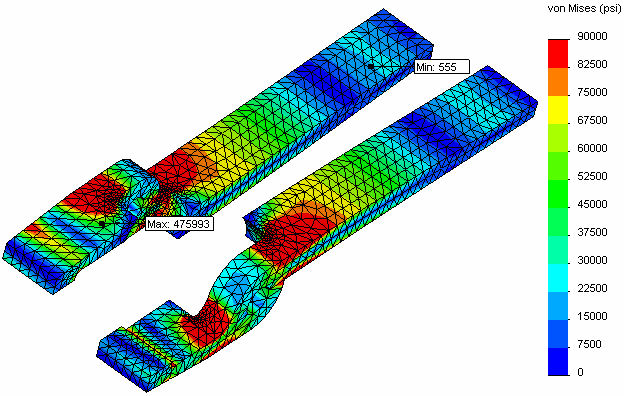
Running a fatigue analysis is a growing trend in mechanical parts and assemblies. You must already familiar with stress analysis, as it is the basis for fatigue analysis. Stress or strain information from a stress analysis is the basis for predicting how many lifecycles a component will last. While this can be done by hand, using FEA or hybrid methods produce the best results. It will be clear why that is soon enough.
The general process of fatigue analysis:
- Determine the amount of time you need to a component to last and how many cycles you estimate that represents.
- Perform a stress analysis (hand calculation or FEA) for each load that may be present in a loading cycle.
- Assess the number of cycles each loading event in the cycle will see.
- Find a fatigue curve(s) for you material with the correct loading ratio to find the damage produced by your stress level for each loading event.
- Combine the damages together and multiply by a desired factor of safety.
- Put your hands together pray the damages don’t exceed 1! You don’t want to redesign the part!
The Problem With Hand-Calculated Fatigue Analysis
The first problem with a hand-calculated fatigue analysis for stress is that fatigue is highly dependent on accurate stress predictions. With anything but the simplest of geometries, most Engineers make assumptions that make the calculations easier but sacrifice accuracy. In most cases, a larger factor of safety (usually ~3) ensures an uncertainty is accounted for and the design is safe. However, since fatigue life has a logarithmic type relationship with stress, this simplified, factored stress may not even be in the ballpark for a fatigue life estimation.
Secondly, fatigue isn’t something that happens only at the point of highest stress in the material. It happens everywhere. If the load changes as the component moves through the load cycle, there may be multiple peak stress areas. Furthermore, the failure may happen in an area with somewhat high stresses in every load event, but never the peak stress. This means that accounting for work at every point in the model is necessary.
To do this by hand would require either extremely complex math (read: error prone) dealing with partial differential equations, or calculating stresses at many points for each load case. Either case is unproductive and slower than FEA, which quickly (relative to the complexity) gives stress results at all points in the model. From there the software can combine loading events and, in a fast, efficient method, take fatigue into consideration at all points in the model. A manual method will never be efficient by comparison.
Share
Meet the Author

